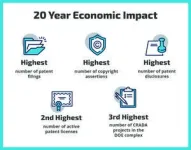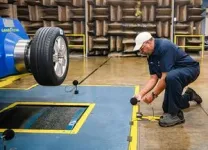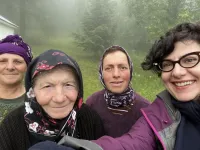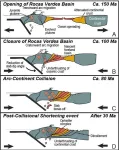(Press-News.org) ALBUQUERQUE, N.M. — To say that the technology and products Sandia National Laboratories researchers have helped imagine, innovate and industrialize have had a massive impact on the country would be an understatement.
Two studies commissioned by Sandia and the National Nuclear Security Administration show Sandia’s work has had an overall economic impact of $140 billion since the year 2000. That’s a significant figure, especially considering it spans just 20 years, less than a third of Sandia’s 75-year existence.
“I am very proud of how Sandia excels in fulfilling its technology transfer mission to deliver economic impact to the U.S.,” said Senior Manager of Business Development Mary Monson. “Sandia’s contribution of $140 billion over 20 years makes it a leader among Department of Energy laboratories.”
Impact in dollars and cents
The two studies, conducted by TechLink, a federally funded technology transfer center at Montana State University, show: $140 billion in overall economic impact, $72.2 billion in new product sales, $22.52 billion in new product sales to the government, $14.1 billion in new tax revenue and 607,246 jobs created.
The studies examined Sandia’s Cooperative Research and Development Agreements and patent license agreements between 2000 and 2023, assessing how they translated into actual products, sales, tax revenue and jobs. This benefits the national economy, improves the nuclear weapons stockpile for the United States and international allies and supports NNSA missions.
“The Nuclear Security Enterprise is a treasure trove of commercializable technologies, and Sandia National Laboratories stands apart in its efforts to bring products to market,” said acting Director of NNSA’s Office of Technology and Partnerships, Jahleel Hudson.
Cooperative Research and Development Agreements and Patent License Agreements
Cooperative Research and Development Agreements and Patent License Agreements are two ways Sandia helps move its technology to industry.
CRADAs are unique contractual vehicles that enable federal labs and outside parties to jointly develop new technologies, leveraging each other’s expertise and resources.
PLAs are legally binding contracts that give licensees, usually for-profit corporations, the right to make, use and sell federal government-owned inventions.
Sandia has excelled in these agreements. According to the FY22 DOE Office of Technology Transitions annual data call, Sandia had:
The highest number of patent disclosures and filings and copyright assertions
The second highest number of active patent licenses
The third highest number of CRADA projects in the DOE enterprise
DOE Boost
In recent years, Sandia has accelerated its efforts to move innovation to industry through the creation of new programs. One such program is the DOE Boost Platform, led by Sandia and external partner FedTech, which partners with 13 other DOE labs. The goal is to bring national labs, startups, academia and entrepreneurs together to find solutions to community-based energy challenges, especially in rural areas.
Sandia is already negotiating three licenses under this program, including one with a team of New Mexicans and Alaskans.
“They are looking to use Sandia’s algae technology in Santa Fe’s municipal water system,” Monson said. “It highlights the fact that communities want to work with people and entrepreneurs from their community to focus on the challenges they’re facing. It’s kind of like the whole impetus behind boost.”
C4 Partnering Model
Another successful program is the C-4 Partnering Model. The four C’s stand for Co-locate, Collaborate, Community and Communicate. It works with seven lab partners and regional partners to develop a regional commercialization ecosystem for manufacturing clean energy technologies focused on collaboration and rapid technology development.
S2EDGE
A third program is the Semiconductor Sector S2-EDGE program. EDGE stands for Expedite and Develop Game-Changing Exemplar. In collaboration with four other labs, it aims to harness industry use-inspired input to move innovations in semiconductor technologies and next-generation microelectronics from the lab to the market.
Monson says these programs are just part of the reason Sandia’s tech transfer numbers are so positive.
“We are committed to bringing new programs to our ecosystem that researchers can take advantage of to move labs-developed technologies to the market,” she said.
Success Stories – Goodyear
This massive economic impact has been fueled by some long-lasting partnerships including that with Goodyear. In the early 90s, the tire company turned to Sandia for its expertise in advanced computational mechanics, simulation and structural dynamics to improve tire performance, reduce product development times, and improve manufacturing methods.
Thirty years later, that partnership continues. One of its latest projects is a virtual way to develop a quieter tire without the need for physical testing. Over the years, the partnership has also resulted in the development of the Assurance TripleTred, a visually distinctive all-weather tire, and the development of Virtual Flat Track, which uses computer simulations to test a virtual tire on a virtual test track simulating actual road conditions.
All of this technology has roots in Sandia’s nuclear deterrence mission.
PNM
Sandia is also involved in ongoing work with the Public Service Company of New Mexico. In 2020, the two formalized a CRADA to help PNM develop a more resilient, clean electric grid and meet a 2040 carbon emissions-free target.
The partners are developing new analytical approaches, capabilities and technologies to help PNM use distributed and centralized sources of clean energy. Sandia and PNM will explore different types of storage, such as batteries, thermal storage and hydrogen that can provide grid resilience. Together, the partners can work to test solutions in real-world scenarios.
hCMOS
Last year, Sandia celebrated its partnership with an Albuquerque-based startup, Advanced hCMOS systems, to commercialize the world’s fastest burst-mode X-ray camera created at Sandia. The company was co-founded by former Sandia employees Liam Claus and Marcos Sanchez, who took advantage of the Entrepreneurial Separation for Technology Transfer program to start their own business.
While the technology is used as part of Sandia’s nuclear power and fusion work, there are many other applications, including astrophysics research, laser design and materials science. Researchers are looking to use it for, among other things, developing stronger glass screens for cell phones. They need to understand how glass fractures. In order to do that, they must see it as it happens at extremely high speeds.
The company is already serving government customers and is working on ramping up production through a DOE Phase I Small Business Innovation Research Grant and a TRGR Technology Readiness Initiative project.
75 years of innovation
With 75 years of innovation behind it, Sandia is looking to make an even bigger impact in the years ahead.
Commercialization of lab developed technologies has long been part of Sandia’s mission, but it is also a reminder that this national lab is made up of some of the brightest minds in the country. Through these partnerships and programs, this work can make its way into the real world and affect everyday lives. Something Sandia and NNSA are proud of.
“Over the last 20 years, Sandia’s economic impact has generated billions of dollars, created half a million high-paying jobs and positioned the United States as a leader in technological innovation,” Hudson said. “NNSA’s Technology and Partnerships Office values Sandia’s extraordinary achievements and is delighted to have commissioned the study to recognize this success.”
For more information on Sandia technology and its impacts, visit 70 ways Sandia has changed the nation.
Sandia National Laboratories is a multimission laboratory operated by National Technology and Engineering Solutions of Sandia LLC, a wholly owned subsidiary of Honeywell International Inc., for the U.S. Department of Energy’s National Nuclear Security Administration. Sandia Labs has major research and development responsibilities in nuclear deterrence, global security, defense, energy technologies and economic competitiveness, with main facilities in Albuquerque, New Mexico, and Livermore, California.
Sandia news media contact: Kim Vallez Quintana, kdquint@sandia.gov, 505-537-3294
END
Sandia pumps $140B into the economy through technology development
Yes, that’s billion with a B
2024-04-03
ELSE PRESS RELEASES FROM THIS DATE:
Even moderate alcohol usage during pregnancy linked to birth abnormalities, UNM researchers find
2024-04-03
University of New Mexico researchers have found that even low to moderate alcohol use by pregnant patients may contribute to subtle changes in their babies’ prenatal development, including lower birth length and a shorter duration of gestation.
In a new paper published in the journal Alcohol Clinical & Experimental Research, a team led by Ludmila Bakhireva, MD, PhD, MPH, professor and assistant dean for Clinical and Translational Research in the UNM College of Pharmacy, also reported some sex-related differences in the effects of drinking during pregnancy on the developing ...
Sylvester physician co-authors global plan to combat prostate cancer
2024-04-03
MIAMI, FLORIDA (EMBARGOED UNTIL APRIL 4, 2024, at 6:30 pm EDT) – Annual prostate cancer cases worldwide are projected to double by the year 2040, and annual deaths are projected to increase by 85% to almost 700,000 over the same timeframe – mainly among men in low- and middle-income countries. A commissioned report published online in The Lancet on April 4 highlights the future landscape of prostate cancer and seeks to guide cancer experts worldwide on how to manage the massive influx of prostate cancer patients projected over the next two decades.
Brandon Mahal, M.D., radiation oncologist and ...
Last chance to record archaic Greek language ‘heading for extinction’
2024-04-03
A new data crowdsourcing platform aims to preserve the sound of Romeyka, an endangered millennia-old variety of Greek. Experts consider the language to be a linguistic goldmine and a living bridge to the ancient world.
The initiative, led by Professor Ioanna Sitaridou from the University of Cambridge, contributes to the UN’s International Decade of Indigenous Languages (2022-32), which aims ‘to draw global attention on the critical situation of many indigenous languages and to mobilise stakeholders and resources for their preservation, revitalization and promotion.’
Romeyka is thought to have only a couple of thousand ...
Chicks prove vision and touch linked at birth
2024-04-03
Newly hatched chicks raised in darkness and allowed to touch either a smooth or bumpy cube for 24 hours instantly recognised the object with their vision upon first exposure to light.
This suggests chicks can link touch and vision without any prior experience combining these senses, challenging the long-held belief that such integration requires learning.
The discovery implies a pre-wired ability in the brain for cross-modal perception, potentially redefining our understanding of animal cognition and sensory processing.
In a study published in Biology Letters, researchers at Queen Mary University of London have cracked ...
Researchers propose new step in tectonic squeeze that turns seafloor into mountains
2024-04-03
Scientists use tiny minerals called zircons as geologic timekeepers. Often no bigger than a grain of sand, these crystals record chemical signatures of the geological environment where they formed. In a new study led by scientists at The University of Texas at Austin, researchers used them to describe what could be an overlooked step in a fundamental tectonic process that raises seafloors into mountains.
In a study published in the journal Geology, the researchers describe zircons from the Andes mountains of Patagonia. Although the zircons formed when tectonic plates were colliding, they have a chemical signature associated ...
Gut bacteria that strongly influence obesity are different in men and women, study finds
2024-04-03
Novel approach finds gut microbiota that are highly predictive of BMI, waist circumference, and fat mass are different in men and women
And might change the chemical makeup (metabolome) of the gut in ways that affect the metabolism of different bioactive molecules that influence metabolic disease development
Interventions to help prevent obesity-favourable microbiome may need to be different in men and women
*This is an early press release from the European Congress on Obesity (ECO 2024) Venice 12-15 May. Please credit the Congress if using this material*
New research being presented at this year’s European ...
Double trouble: the risks of mixing alcohol and sports wagering
2024-04-02
It turns out that money isn’t the only thing sports gamblers are risking. According to a new study, bettors who wager on sporting events, esports, and daily fantasy sports are much more likely than other individuals to binge drink.
The findings, compiled by a research team from UNLV and the University of New Mexico, were published this week in the journal JAMA Network Open.
Over the course of three weeks in spring 2022, researchers surveyed more than 4,300 adults across the U.S. Nearly 3,300 self-reported past year alcohol use, while about 1,800 identified themselves as gamblers who had bet on sports in the past year.
Researchers ...
Far-UVC light can virtually eliminate airborne virus in an occupied room
2024-04-02
NEW YORK, NY--Far-UVC light is a promising new technology for reducing airborne virus levels in occupied indoor spaces, but its effectiveness has not been evaluated in real-life scenarios.
A new study by Columbia researchers now shows that far-UVC light inactivated nearly all (>99%) of an airborne virus in an occupied work environment, showing that the technology can work as well in a real-life scenario as in the laboratory.
“The results show that far-UVC is highly effective at reducing airborne pathogens in an ordinary occupied room, and so it’s practical to use far-UVC light in indoor areas where people are going about their business,” says David ...
A new estimate of U.S. soil organic carbon to improve Earth system models
2024-04-02
Soil contains about twice as much carbon as the atmosphere and plants combined. It is a major carbon sink, capable of absorbing more carbon dioxide from the atmosphere than it releases. Management of soil carbon is key in efforts to mitigate climate change, in addition to being vital to soil health and agricultural productivity.
Measuring soil carbon, however, is a painstaking, expensive process. Samples must be dug from the ground and sent to a lab for analysis, making upscaling measurements on a large spatial scale ...
Scientists’ urgent call: end destruction and forge a just, sustainable future
2024-04-02
An international team of scientists published a study today in the Proceedings of the National Academy of Sciences NEXUS emphasizing the urgent need to align political will, economic resources, and societal values to ensure a more sustainable and equitable world. Led by University of Hawai‘i at Mānoa researchers, the 18 authors combine their expertise in earth and ocean sciences, politics, law, public health, renewable energy, geography, communications, and ethnic studies to assess causes, impacts, and solutions to a multitude of worldwide crises.
“Climate change, ecological destruction, disease, pollution, and socio-economic inequality ...
LAST 30 PRESS RELEASES:
A JBNU–KIMS collaborative study on a cost-effective alloy matches superalloys for power plants and energy infrastructure
New study overturns long-held model of how plants coordinate immune responses.
New AI model predicts disease risk while you sleep
Scientists discover molecular ‘reshuffle’ and crack an 80-year-old conundrum
How stressors during pregnancy impact the developing fetal brain
Electrons lag behind the nucleus
From fungi to brain cells: one scientist's winding path reveals how epigenomics shapes neural destiny
Schizophrenia and osteoporosis share 195 genetic loci, highlighting unexpected biological bridges between brain and bone
Schizophrenia-linked genetic variant renders key brain receptor completely unresponsive to both natural and therapeutic compounds
Innovative review reveals overlooked complexity in cellular energy sensor's dual roles in Alzheimer's disease
Autism research reframed: Why heterogeneity is the data, not the noise
Brazil's genetic treasure trove: supercentenarians reveal secrets of extreme human longevity
The (metabolic) cost of life
CFRI special issue call for papers: New Frontiers in Sustainable Finance
HKU Engineering scholar demonstrates the smallest all-printed infrared photodetectors to date
Precision empowerment for brain "eavesdropping": CAS team develops triple-electrode integrated functional electrode for simultaneous monitoring of neural signals and chemical transmitters during sleep
Single-capillary endothelial dysfunction resolved by optoacoustic mesoscopy
HKU three research projects named among ‘Top 10 Innovation & Technology News in Hong Kong 2025’ showcasing excellence in research and technology transfer
NLRSeek: A reannotation-based pipeline for mining missing NLR genes in sequenced genomes
A strand and whole genome duplication–aware collinear gene identification tool
Light storage in light cages: A revolutionary approach to on-chip quantum memories
Point spread function decoupling in computational fluorescence microscopy
BacPhase: Long-insert paired-end sequencing for bin marker construction and genome phasing
GmWOX1 regulates the mediolateral polarity of compound leaves in soybean
ChargeFabrica: An open-source simulation tool that aims to accelerate search for high performance perovskite solar cells
High levels of ADAR overexpression induce abundant and stochastic off-target RNA editing in rice protoplasts
On-demand upgraded recycling of polyethylene and construction of sustainable multifunctional materials based on the "LEGO" strategy
New "Stomata in-sight" system allows scientists to watch plants breathe in real-time
Anorexia nervosa may result in long-term skeletal muscle impairment
Narrative-based performance reviews deemed fairest by employees
[Press-News.org] Sandia pumps $140B into the economy through technology developmentYes, that’s billion with a B







